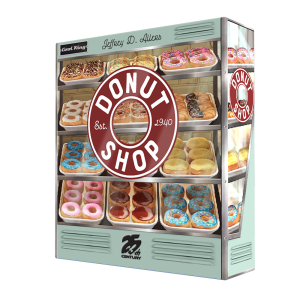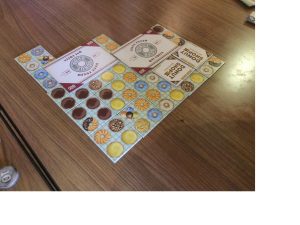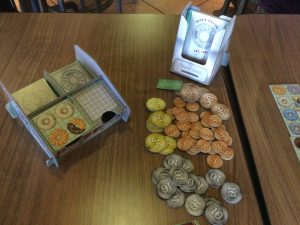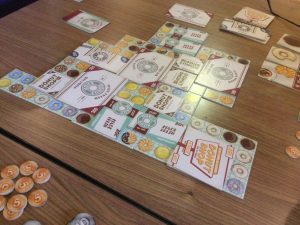| Publisher | 25th Century Games |
| Design Credits | Jeffrey Allers |
| Art Credits | Nick Whittle, James Churchill, Matt Paquette & Co. |
| Editing Credits | Ric White, Joel Finch |
| Game Contents | Money tokens (52 5-cent, 25 10-cent, 17 25-cent, 10 50-cent, and 10 100-cent pieces), 20 Donut Boxes (four each of 4-, 6-, 8-, 9-, and 12-doughnut containers), Donut Display Case tile, 40 Donut Tiles, 40 Order cards, “Napkin Dispenser,” “Donut Rack,” rules |
| Guidelines | Tile-laying doughnut-displaying game |
| MSRP | $30 ($40 for the deluxe version, with the Blue Plate Special (and hats) expansion available separately) |
| Reviewer | Andy Vetromile |
The year is 1939 (presumably – the game is long on theme and short on explanation – and yes, the (original mockup?) cover image above says 1940) and people are going crazy for the new Donut Shop on the corner. It takes a lot of employees to cover this many customers and there’s competition to stand out as the biggest earner.
The object is to score the most points.
The Donut Shop has two to four fresh hires all vying to be the star employee in this new venture. They want to sate the appetites of the most customers in pursuit of the raises, praises, and employee-of-the-month plaques that are the due of the best rep in the company. Everyone starts with a Donut Tile, an Order card, and a four-doughnut box. A turn consists of placing a tile, scoring it, perhaps boxing up some goodies for a customer, and getting new cards and tiles. The Donut Display Case is a central board everyone plays off: Tiles are placed all around it and you get points – that is to say, money – when you establish a chain of orthogonal doughnuts of one flavor. If you have Order cards to cover them, you may place a Donut Box tile over a matching set of treats. For example, if there’s a two-by-three set of pastries in evidence composed of banana cream doughnuts and crullers, so long as you can play two cards, one for each type, you can cover those delights with a six-doughnut box for more pennies. Bigger boxes, bigger payouts.
A few tiles show a stack of doughnut holes and this counts as “wild” when determining adjacency for scoring. They can also be retasked as whatever flavor a player likes when placing additional Donut Tiles or boxing the goods. Along those lines, two of the same doughnut Order cards can be paired up and used as a single “wild” of the player’s choice when boxing. A few cards show sprinkles – worth bonus points if your container covers same – and sets of cards showing coffee are worth even more still. After their turn the player replenishes their hand with a new tile and another Order card; there are always two faceup of each while the rest are facedown and one must take one of each, the “known” and then the blind draw. Once the draw decks are empty it’s time for the last turn and then the game ends in sweet victory for the high scorer.
Like the doughnuts themselves, presentation makes all the difference and Donut Shop does not disappoint. The playing pieces, starting with the cross-shaped Display Case and moving to the dispensers, are impressive, the former for its robust nature (duplicated by the Donut Tiles you surround it with) and the latter for just looking mondo-cool. One is a “napkin holder” where the Order cards deck is stored and the other is a rack where the stacks of doughnuts await. Punching them is a ginger affair, trying not to break or bend a few fiddly bits where thin slots are formed, but putting them together is easy. It ought to be: They dedicate two full pages of the rule book you’ll never use again to the diagrams showing how to achieve construction. Once built they still fit back in the box so there’s no need to take them apart, something not every game accounts for when including fanciful centrepieces. The pictures therein are extremely sharp and clear, which is good because there’s not a lot of text to follow or labeling of each piece otherwise.
Some of the pastries, in situ, look a bit too much like another since some of the treats have sprinkles, which in turn make it look “round with spots” (but they’re still attractive) and the crullers are distractingly half-covered in chocolate. (Yes, how would the sprinkles attach themselves to a cruller without that frosting? But does it have to be cocoa, like the chocolate doughnuts? Yet without it they might look like the frosted . . .) They must have ultimately made the right graphic choices following some deliberation because the tiles still look marvelous. The Order cards err on the thin side but are enticing and shuffle well, and the money rounds things out with both a sturdy stock and a good distribution – it finds that sweet spot where you use much of the money without running out easily.
Donut Shop is a satisfying couple of twists on some standard mechanical entries. Putting everyone to work on the shared central board is cool, especially since once someone scores big for an ever-increasing grouping of banana-cream doughnuts the rest of the crew is going to look for ways to score the same thing on their turn – and then, they hope, cut subsequent attempts off by blocking those confections with a box smack in the middle of the board. This is the ever-present danger for the game: Every time you place your tile on the board you’re looking to boost your score without handing a victory to someone with the right combination of Order cards. You can’t simply not play a tile but if you don’t get money on your turn you risk falling behind. This can be compensated for by getting cards for powerful boxing bonuses of one’s own but will it be enough in such a brief game?
With the right smattering of wild “doughnut hole” tiles and extra points for sprinkles and coffee, the tile and card selections are a small but powerful set of options for furthering your career in the culinary arts. One cannot help but feel the whole thing could go longer, but it doesn’t overstay its welcome and the “everyone gets one last turn” endgame is, unlike some game entries, effective and consequential. (The game can extend a bit if you buy the deluxe version or the upgrade Blue Plate Special pack, which offers a few more cards, tiles, and point variations – and four cloth hats in retro diner style.) While not breaking much new ground, Donut Shop does a lot of things other games already do, it just does them better. When you box up the mechanics, the execution, and the pieces you realize there’s but one component missing from every container of Donut Shop and that is . . . a box of doughnuts.



